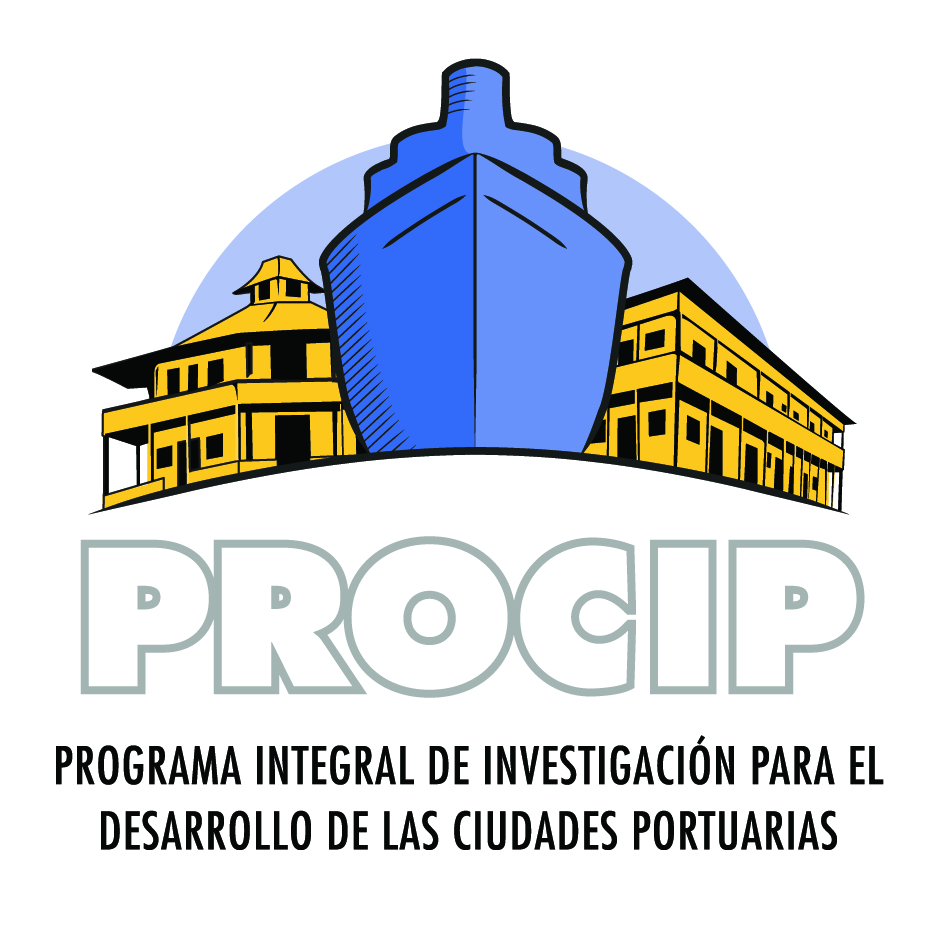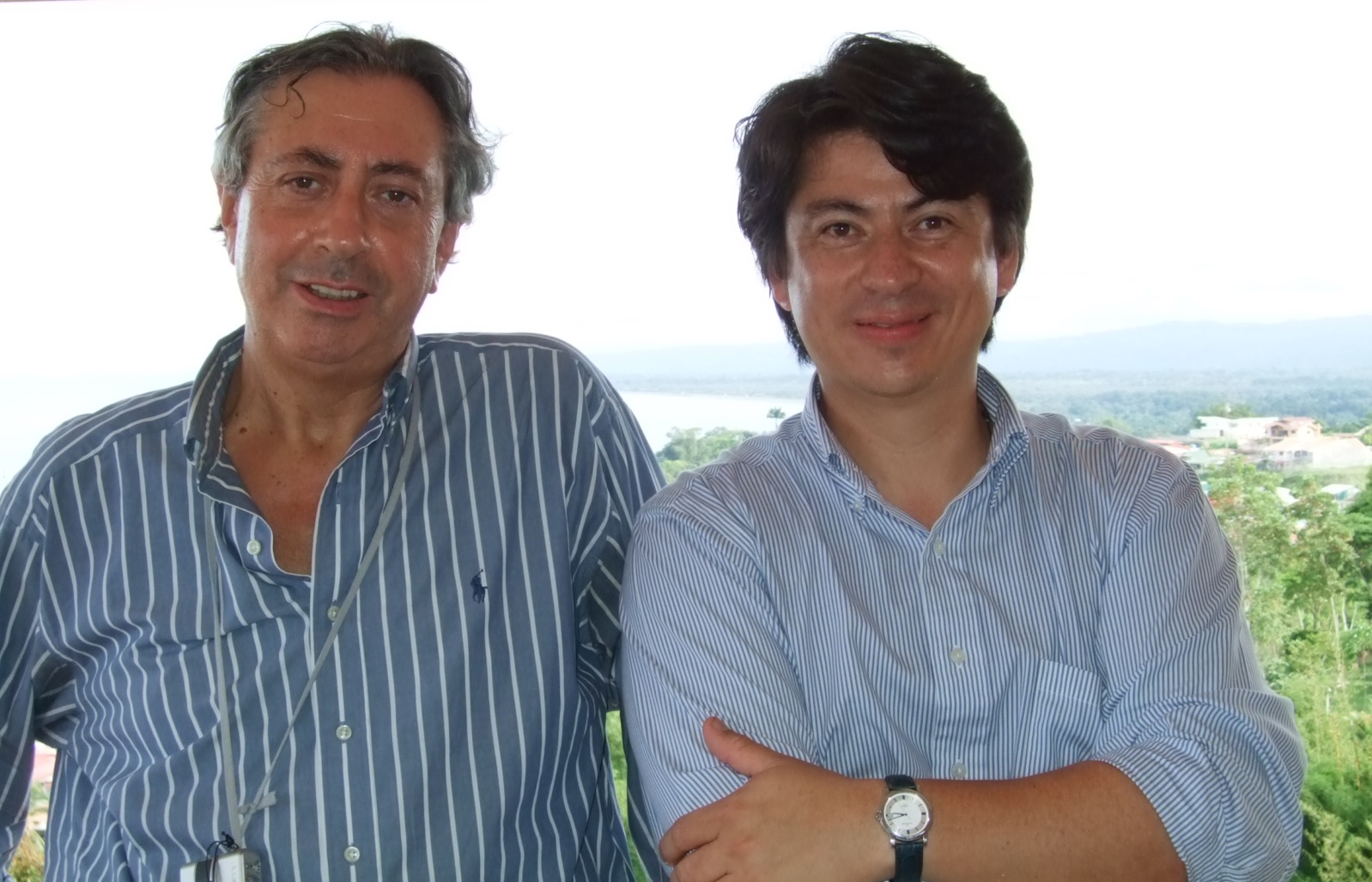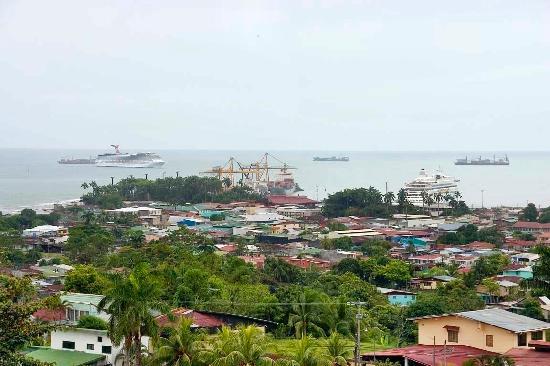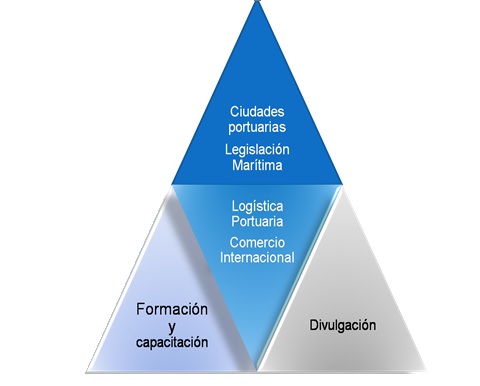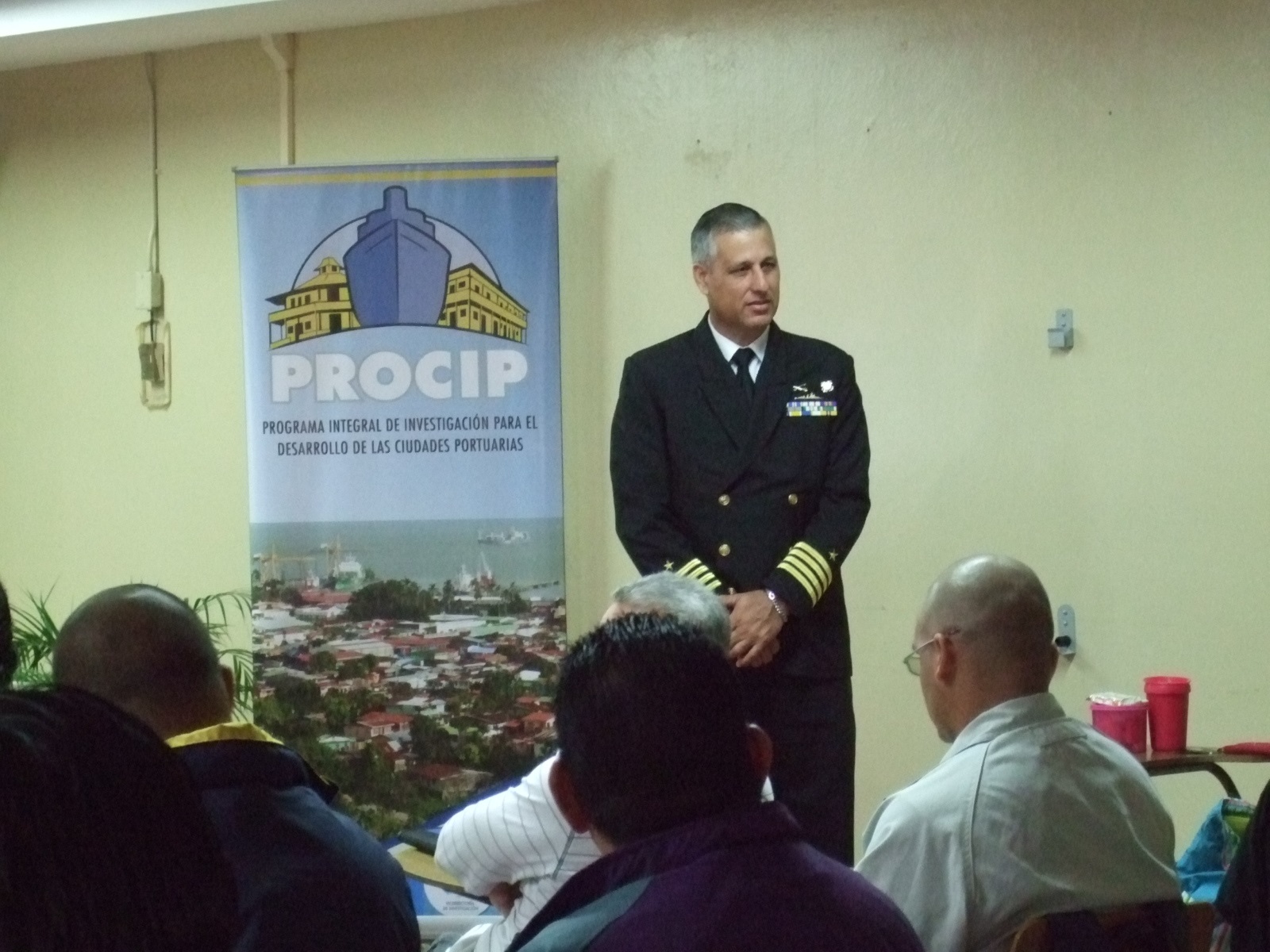The Integral Research Program for the Development of Port Cities (acronym in Spanish as PROCIP) celebrates its first 10 years, with great satisfaction for the achievements, and at the same time, with great enthusiasm for the new challenges.
The PROCIP logo contains the image of two emblematic buildings, on the left, the Capitanía de Puertos of the city of Puntarenas (Pacific Ocean), and on the right, the “Black Star Line”, icon of the city of Limón (Caribbean Sea).
The PROCIP is an organization dedicated to scientific research, which deals with the study, social dynamics, relations and political decisions, economic forces and environmental problems of the port cities of Costa Rica and the Central American region. In addition, it promotes maritime and port education, and the participation of local authorities, in the creation of planning and governance instruments, this with the objective of capitalizing on the potential of the territory and contributing to improving the living conditions of its inhabitants.
This program was created at UNED, Universidad Estatal a Distancia of Costa Rica and it is formalized through Agreement III, paragraph 3, of the 2001-2009 session of the University Council, held on October 15, 2009.
PROCIP has a broad network with other national and international organizations, which share similar interests and experiences. Among them are: RETE (Association for Collaboration between Ports and Cities), AIVP (World Association of Port Cities), AAPA (American Association of Port Authorities), COCATRAM (Central American Commission for Maritime Transport), MOPT (Ministry of Public Works and Transport of Costa Rica), Red-LATAM (Expanded Latin American Network), IMO (International Maritime Organization), OEA-CIP (Inter-American Committee on Ports of the OAS), ITCA-FEPADE (Central American Technological Institute and Business Foundation for Educational Development) and , Mayors of the coastal cantons of Costa Rica such as Quepos, Puntarenas, Limón and Golfito.
From left to right; Rinio Bruttomesso, president of RETE and Roger Ríos, coordinator of PROCIP. Visit to the city of Limón, 2010.
One of the great challenges has been the re-conceptualization of port cities, given that most of the literature focuses on cases of highly developed and industrialized societies, which in many ways contrast with the Central American reality. This decade of work has allowed us to understand that it does not make much sense to assume the port city as the object of study, and that the most convenient, in methodological terms, is to understand the port city as the context of a series of specific issues. The approach to research topics from a geographical perspective has been of great methodological value. For example, the distinction of Hinterland, Waterfront, Foreland and the port enclosure has facilitated the location of key social actors, as well as the mapping of productive chains and economic dynamics. In addition, it has led to the recognition of cultural corridors, which are spaces with great historical and symbolic importance, often used as meeting points, around artistic, sports and even social struggle events. Adding to the above the social analyzes, important results have been obtained in the task of understanding the port cities and their environments.
Puerto Limón faces major social and economic challenges today, so the academic and coordination work of PROCIP is much more justified.
The PROCIP was created with three working lines: Research, training and dissemination. However, research is the most important activity, and some of the research carried out can be mentioned here.
PROCIP structure, according to their work areas.
- “Analysis of Port Logistics applied to the Limón-Moín port enclave, 2009-2010”. A study that considered the types of cargo, the capabilities of transport services and the economic impacts to the hinterland.
- “Costa Rican Maritime and Port Legislation in the face of maritime transport and globalized trade challenges 2009-2010”. It evaluated national regulations and identified significant shortcomings that require updating, and the ratification of several IMO conventions.
- “SMEs in the neighborhoods near the port of Limón: Towards the creation of a 2010-2011 Port Cluster”. The labor market and the potential reorientation of many SMEs towards auxiliary maritime industries were analyzed. The objective generated inputs to face the economic and social transformation that represented the concession of the port operations to the APM Terminals company in Costa Rica.
- “Diagnosis and evaluation of the maritime port sector of Costa Rica 2012-2013”. A disarticulated, dispersed and uncoordinated sector was found, in view of which a reorientation was proposed that considered creating a Strategic Zone in the Caribbean: Costa Rica – Panama; taking advantage of the potentialities projected with the new locks of the Panama Canal and the TCM in Moín, Limón.
- “Biological, social and economic impacts, due to the introduced species of lionfish (P. volitans / thousands complex), in the Caribbean region Costa Rica 2015-2016”. It focused on the topic of mitigation and adaptation to invasive species, estimating the density and abundance of the species for four sites over two years and showing a slight tendency to increase. A base was created that allows to measure affectations and concrete actions of environmental education were implemented.
The second working line of PROCIP in importance corresponds to training and education programs. These have been developed through cooperation agreements with various institutions that make up the network. The courses generally respond to specific requests from professional groups or institutions.
The PROCIP, in partnership with the Maritime University of Panama, facilitated the “Yacht Captain” course for 21 officials of the National Learning Institute –INA (2011).
Some of the courses taught are “Yacht Captain”, “Port operations and cargo planning in container terminals”, “Maritime Law”, “Management of dangerous cargo” and others, on environmental, urban and governance issues.
Finally, the third working line of PROCIP is dissemination, which has worked with an annual calendar of conferences, in which results of research and experiences on issues of the port-city relationship are presented. In addition, there have been six international symposiums and more than 40 colloquiums on the theme of port city, which have the ultimate goal of literacy to the community on port and maritime issues, so that they get to better understand their own environment.
Over these 10 years, agreements have been formalized, strategies, research and consolidated national and international networks have been developed. Undoubtedly, all this work of PROCIP has contributed in the work of understanding and valuing port cities.
The port cities of Costa Rica need a lot of attention, they need to re-discover their potential, repair their functionality and plan to connect with the world.
Puntarenas, Limón, Quepos, Golfito, Costa de Pájaros and all coastal communities must be understood as port cities, while living a direct relationship with the sea, and are impacted by port activities. Many of its cultural and / or socioeconomic changes, of its transformations in the labor market, in urban and industrial development and even the way of addressing environmental issues, derive from the port city relations. Hence the importance of maintaining an informed and capable citizenship to propose new dynamics, when these are required.
Head image: This image of the city of Limón was used in November 2010, in the materials of a working day, organized by PROCIP with RETE, ARUP, the port of Santander, CITAP´s and others.
PROCIP: Década Uno
El Programa Integral de Investigación para el Desarrollo de las Ciudades Portuarias (PROCIP) celebra sus primeros 10 años, con mucha satisfacción por los logros alcanzados, y a la vez, con mucho entusiasmo por los retos presentes.
El logo del PROCIP contiene la imagen de dos edificios emblemáticos, a la izquierda, la Capitanía de Puertos de la ciudad de Puntarenas (Océano Pacífico), y a la derecha, el “Black Star Line”, icono de la ciudad de Limón (Mar Caribe).
El PROCIP es un organismo dedicado a la investigación científica, que aborda como objeto de estudio, las dinámicas sociales, las relaciones y decisiones políticas, las fuerzas económicas y las problemáticas ambientales de las ciudades portuarias de Costa Rica y la región centroamericana. Además, promueve la educación marítima y portuaria, y la participación de las autoridades locales, en la creación de instrumentos de planificación y gobernanza, esto con el objetivo de capitalizar las potencialidades del territorio y contribuir a mejorar las condiciones de vida de sus habitantes.
Este programa se creó en la Universidad Estatal a Distancia de Costa Rica y se formaliza mediante el Acuerdo III, inciso 3, de la sesión 2001-2009 del Consejo Universitario, celebrada el 15 de octubre del 2009.
El PROCIP tiene una amplia red de trabajo con otras organizaciones nacionales e internacionales, que comparten intereses y experiencias similares. Entre ellas están: RETE (Asociación para la Colaboración entre Puertos y Ciudades), AIVP (Asociación Mundial de Ciudades Portuarias), AAPA (Asociación Americana de Autoridades Portuarias), COCATRAM (Comisión Centroamericana de Transporte Marítimo), MOPT (Ministerio de Obras Públicas y Transportes de Costa Rica), Red-LATAM (Red Latinoamericana Ampliada), OMI (Organización Marítima Internacional), OEA-CIP (Comisión Interamericana de Puertos de OEA), ITCA-FEPADE (Instituto Tecnológico Centroamericano y Fundación Empresarial para el Desarrollo Educativo) y, Alcaldías de los cantones costeros de Costa Rica como son Quepos, Puntarenas, Limón y Golfito.
De izquierda a derecha: Rinio Bruttomesso, presidente de RETE, y Roger Ríos, coordinador de PROCIP. Visita a la ciudad de Limón, 2010.
Uno de los grandes retos ha sido la re-conceptualización de las ciudades portuarias, dado que la mayor parte de la literatura se enfoca en casos de sociedades altamente desarrolladas e industrializadas, que en muchos aspectos contrastan con la realidad centroamericana. Esta década de trabajo ha permitido comprender que, no tiene tanto sentido asumir la ciudad portuaria como el objeto de estudio, y que lo más conveniente, en términos metodológicos, es comprender la ciudad portuaria como el contexto de una serie de temas específicos. La aproximación a los temas de investigación desde una perspectiva geográfica ha resultado de gran valor metodológico. Por ejemplo, la distinción del Hinterland, del Waterfront, del Foreland y del recinto portuario, han facilitado la ubicación de actores sociales clave, así como también el mapeo de los encadenamientos productivos y las dinámicas económicas. Además, ha propiciado el reconocimiento de corredores culturales, que son espacios con gran importancia histórica y simbólica, utilizados muchas veces como puntos de encuentro, en torno a manifestaciones artísticas, deportivas y hasta de lucha social. Sumando a lo anterior los análisis sociales, se han obtenido resultados importantes en la tarea de comprender las ciudades portuarias y sus entornos.
Puerto Limón enfrenta hoy grandes retos sociales y económicos, por lo que la labor académica y de coordinación del PROCIP se justifica mucho más.
El PROCIP se creó con tres ejes de trabajo: Investigación, capacitación y divulgación. Sin embargo, la investigación es la actividad de mayor importancia, y aquí puede mencionarse algunas de las investigaciones realizadas.
Estructura del PROCIP, según sus áreas de trabajo.
- “Análisis de la Logística Portuaria aplicada al enclave portuario Limón-Moín, 2009-2010”. Un estudio que consideró los tipos de carga, las capacidades de los servicios de transporte y los impactos económicos al hinterland.
- “Legislación Marítima y Portuaria Costarricense ante los retos del transporte marítimo y el comercio globalizado 2009-2010”. Evaluó la normativa nacional e identificó falencias significativas que demandan actualización, y la ratificación de varios convenios OMI.
- “PYMES en los barrios próximos al puerto de Limón: Hacia la conformación de un Cluster Portuario 2010-2011”. Se analizó el mercado de trabajo y la potencial reorientación de muchas PYMES hacia industrias marítimas auxiliares. El objetivo generó insumos para enfrentar la transformación económica y social que representaba la concesión de las operaciones portuarias a la empresa APM Terminals de Costa Rica.
- “Diagnóstico y evaluación del sector marítimo portuario de Costa Rica 2012-2013”. Se encontró un sector desarticulado, disperso y descoordinado, ante lo que se propuso una reorientación que consideraba crear una Zona Estratégica en el Caribe: Costa Rica – Panamá; aprovechando las potencialidades proyectadas con las nuevas esclusas del Canal de Panamá y de la TCM en Moín de Limón.
- “Impactos biológicos, sociales y económicos, a causa de la especie introducida de pez león (complejo P. volitans/miles), en la región Caribe Costa Rica 2015-2016”. Se enfocó en la temática de mitigación y adaptación a las especies invasoras, estimando la densidad y abundancia de la especie para cuatro sitios durante dos años y evidenciando una leve tendencia al aumento. Se generó una base que permite medir afectaciones y se implementaron acciones concretas de educación ambiental.
El segundo eje del PROCIP en importancia corresponde a los programas de formación y capacitación. Estos se han desarrollado a través de convenios de cooperación con diversas instituciones que conforman la red de trabajo. Generalmente los cursos responden a solicitudes concretas de grupos profesionales o de instituciones.
El PROCIP en alianza con la Universidad Marítima de Panamá, facilitó la impartición curso “Capitán de Yate”, para 21 funcionarios del Instituto Nacional de Aprendizaje –INA (2011).
Algunos de los cursos impartidos son “Capitán de Yate”, “Operaciones portuarias y planificación de carga en terminales de contenedores”, “Derecho Marítimo”, “Manejo de cargas peligrosas” y otros más, sobre temas ambientales, urbanos y de gobernanza.
Finalmente, el tercer eje del PROCIP es la divulgación, el cual ha funcionado con un calendario anual de conferencias, en las que se presentan resultados de investigaciones y experiencias en temas de la relación puerto-ciudad. Además, se han realizado seis simposios internacionales y más de 40 coloquios sobre sobre la temática de ciudad puerto, que llevan el objetivo último de alfabetizar a la comunidad sobre temas portuarios y marítimos, para que lleguen a entender mejor su propio entorno.
A lo largo de estos 10 años se han formalizado convenios, desarrollado estrategias, investigaciones y consolidado redes de trabajo nacionales e internacionales. Sin duda, todo este quehacer del PROCIP ha aportado un grano de arena en la labor de comprender y valorar las ciudades portuarias.
Las ciudades portuarias de Costa Rica necesitan de mucha atención, necesitan re-descubrirse en su potencialidad, repararse en su funcionalidad y proyectarse para vincularse con el mundo.
Puntarenas, Limón, Quepos, Golfito, Costa de Pájaros y todas las comunidades costeras deben ser comprendidas como ciudades portuarias, en el tanto viven una relación directa con el mar, y son impactadas por las actividades portuarias. Muchos de sus cambios culturales y/o socioeconómicos, de sus transformaciones en mercado de trabajo, en el desarrollo urbano e industrial y hasta la forma de abordar los temas ambientales, se derivan de las relaciones ciudad puerto. De ahí la importancia de mantener una ciudadanía informada y con capacidad para proponer nuevas dinámicas, cuando éstas se requieran.
Head image: Una imagen de la ciudad de Limón, utilizada en noviembre del 2010, en los materiales de una jornada de trabajo, organizada por PROCIP con RETE, ARUP, el puerto de Santander, CITAP´s y otros.
